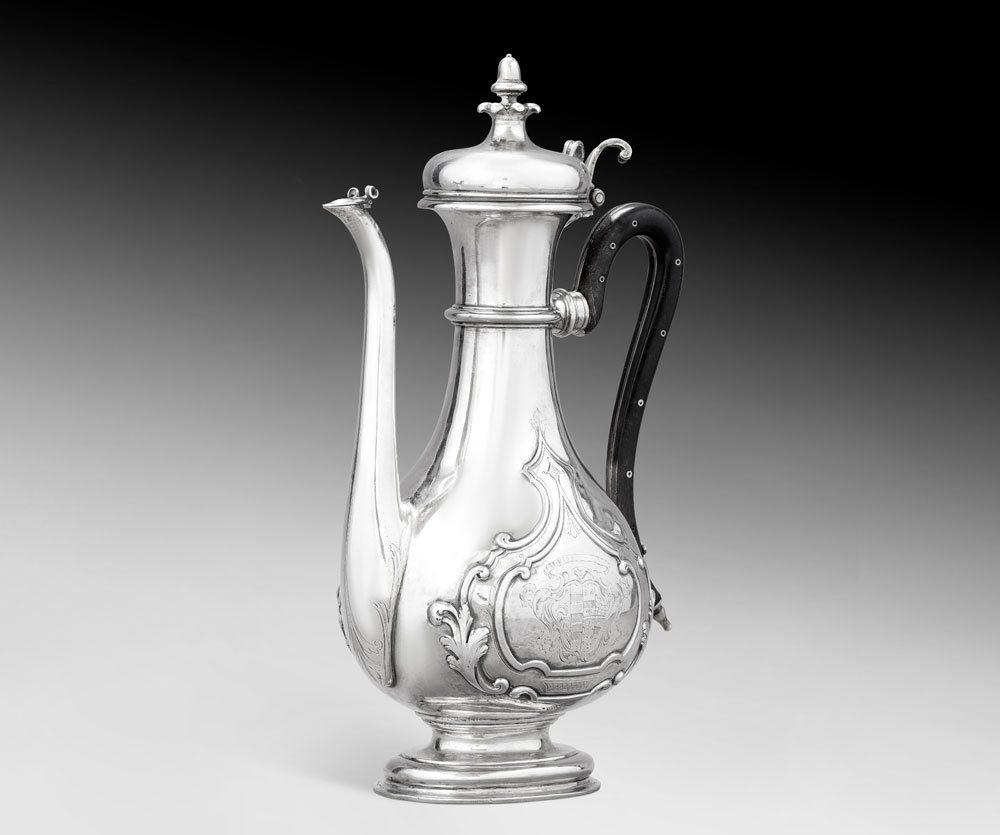| |
Caffettiera in argento, Firenze 1740 ca. argentiere Adriano Haffner (1703-1768)
Su piede a sagoma ovale, gradinato. Il corpo, piriforme, presenta una doppia insegna gentilizia con i blasoni delle nobili famiglie senesi Sansedoni e Venturi Gallerani entro un elegante cartiglio fogliato. Analoghi motivi fogliati decorano la base del lungo versatoio che termina con un piccolo coperchio movibile. Un manicotto cilindrico in argento aderente al collo della caffettiera raccorda il manico ad ansa in legno e decorato da un intarsio di piccoli anelli. Coperchio a cupola espansa con presa cesellata a guisa di ghianda posta su terrazzamento fogliato.
Alt. 30 cm. Peso 1.080 gr.
L’importanza del nobile casato dei Sansedoni, famiglia di aristocratici della repubblica Senese sin dal 1200, perdura nel corso dei secoli grazie alla figura del Beato Ambrogio Sansedoni, o Ambrogio da Siena, compagno di San Tommaso d'Aquino. Per tutto il XVIII secolo, i Sansedoni continueranno ad esercitare la loro influenza politica all’interno del Granducato di Toscana, in particolare attraverso le unioni matrimoniali, come quella tra Antonio Ottavio Sansedoni e Ottavia Venturi Gallerani. I restauri in seguito intrapresi a Palazzo Sansedoni, alcuni dei quali ancora oggi visibili, affermano il prestigio del ramo familiare.
------------------------------------------
A silver coffee pot, Florence, circa 1740 by Adriano Haffner (1703-1768)
standing on an oval spreading foot with steps, the body applied with a large leafy cartridge engraved in its center with covenant coats of arms of Sansedoni and Venturi Gallerani family’s, the spout with removable lid, the cover with a thumb rest formed by two scrolls, the grip in the shape of an acorn on a leafy terrace, the handle in black wood set with round silver motifs.
H. 30 cm, W. 1.080 gr.
The Sansedoni, a family of Sienese aristocrats, were particularly important in the 13th century, thanks to the figure of Blessed Ambrogio Sansedoni or Ambrose of Siena, a companion of Saint Thomas Aquinas. In the eighteenth century, when Siena was no longer an independent republic but belonged to the Grand Duchy of Tuscany, the Sansedoni continued to exert their political influence, particularly through their various marriages, such as that between Antonio Ottavio Sansedoni and Ottavia Venturi Gallerani. The refurbishments undertaken in the Sansedoni Palace, some of which can still be seen today, testify to the importance of this family
-------------------------------------------
Cafetière en argent, Florence, vers 1740 par M. Orfèvre Adriano Haffner (1703-1768)
Reposant sur un piédouche ovale à ressauts, le corps appliqué d'un large cartouche feuillagé gravé en son centre d'armoiries d'alliance des familles Siennoises Sansedoni et Venturi Gallerani, le bec verseur à couvercle amovible, le couvercle à appui-pouce formé de deux rinceaux, la prise en forme de gland sur une terrasse feuillagée, l'anse en bois noir sertie de motifs ronds en argent
Haut. 30 cm, poids total 1.080 gr.
Les Sansedoni, famille d’aristocrates Siennois, furent particulièrement importants au XIIIe siècle, grâce à la figure du Bienheureux Ambrogio Sansedoni ou Ambroise de Sienne, compagnon de Saint Thomas d’Aquin. Au XVIIIe siècle, alors que Sienne n’est plus une république indépendante mais appartient au Grand-Duché de Toscane, les Sansedoni continuent d’exercer leur influence politique, notamment par leurs différents mariages, tels celui entre Antonio Ottavio Sansedoni et Ottavia Venturi Gallerani. Les rénovations alors entreprises au Palais Sansedoni, dont certaines encore visibles aujourd’hui, témoignent de l'importance de cette famille.
|

